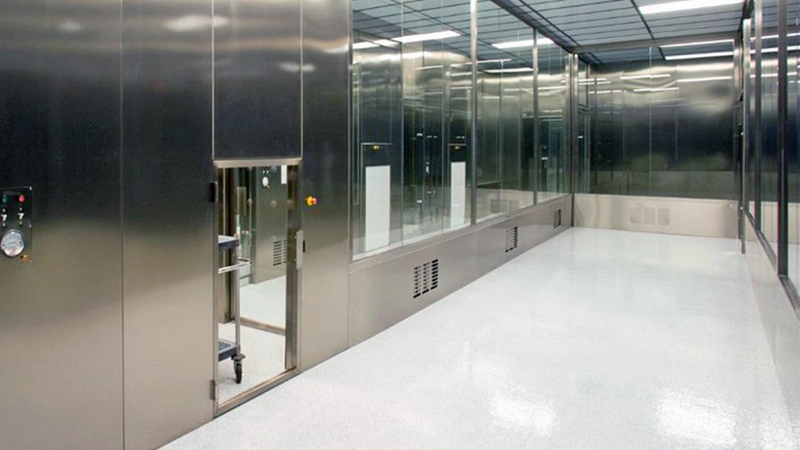- +1 (714) 578-6100
Hours Mon - Fri, 07:00 AM - 06:00 PM (Pacific Time)

Stainless Steel Cleaning Steps and Methods
Posted:
October 14, 2022
Best Practices for Cleaning Stainless Steel
Stainless steel is a key material in cleanrooms and other controlled environments due to its resistance to corrosion and ability to be easily cleaned and sterilized. However, stainless steel must be properly cleaned and maintained to ensure its long-term durability and performance.
In this post, we will discuss stainless steel cleaning methods and techniques, as well as some tips on effectively cleaning and maintaining stainless steel surfaces.
Disclaimer: Always evaluate the compatibility of cleaners and respective instructions before you begin to clean. It is the responsibility of each facility to determine what cleaning chemicals, and which cleaning methods, are most appropriate for the host environment. The contents herein are for discussion purposes only and do not constitute a recommendation for your facility.
Instructions for Stainless Steel Cleaning
- Brush or wipe away any visible debris
- Wash with mild soap or detergent
- Rinse with distilled or deionized water
- Wipe dry with a clean, soft, low-lint wipe
Stainless Steel Cleaning vs Sanitation vs Disinfection
Cleaning refers primarily to removing visible dirt or particles. Many cleaning products integrate various antimicrobial chemicals and ingredients that result in the disinfection of a surface or object. In the simplest terms, cleaning is the act of making something less dirty, which can include many different means and methods.
Sanitation: while the terms sanitizer and disinfectant are often used synonymously, these terms designate two unique classifications of cleaning chemicals. Sanitizers are most frequently associated with chemicals or ingredients that reduce bacteria and colony-forming units (CFUs). Sanitizers encompass antibacterial substances that reduce pathogen CFUs to a safe level. For sanitizers, a 5-log CFU reduction is expected to result in a 99.999% reduction of non-spore-forming bacteria.
Disinfection refers to specific measures taken to control, deactivate or kill infectious agents, such as viruses and bacteria. Disinfection typically occurs once the surface is already clean and free of surface particles or debris. Precleaning is important to ensure that surfaces are free of films, residues, and organic matter. Otherwise, microbes may find a safe harbor among sub-surface layers that liquid disinfectants cannot easily penetrate.
Considerations for Stainless Steel Cleaning
Can I Use Bleach for Cleaning Stainless Steel?
Improper cleaning tools and incompatible chemical use are typical precursors to unsatisfactory wipe-down performance, uneven wetting, and limited working life if rust or oxidation arises.
Minimize Bleach and Chlorine
Bleach and chlorine are potentially detrimental chemical treatments to stainless steel materials and finishes. The effect of bleach and chlorine on metals is broadly dependent on the chemical choice, chemical concentration, and the specific grade of stainless steel.
The negative effects of bleach on stainless steel are most noticeable over many repeated cleaning cycles. Many sporicidal disinfectants are chlorine based and will damage material like stainless steel unless the residue is wiped away after use.
In most residential and commercial applications, bleach is applied at a ratio of 10% bleach, and 90% water. Even at a 10% concentration, frequent bleach exposure is likely to have observable effects on stainless surfaces, thus non-bleach alternatives include quarternary ammonia, isopropyl alcohol, and hydrogen peroxide. Meanwhile, many manufacturers will continue to develop novel bleach formulations that can be safely used with stainless steel to prevent damage, oxidation, and rust.
Can I Use Brushes or Steel Wool for Cleaning Stainless Steel?
Brushes and steel wool are not recommended for cleaning critical stainless steel surfaces in a cleanroom. Steel wool and brushes will not only make the surface look dull, scratched, and weathered, but will also generate microscopic scratches that will make the surface difficult to clean and more susceptible to generating biofilms or microbial growth.
Instead of steel or wire brushes, use a soft nylon brush for heavier soiling to prevent damage to the surface.
Can I Use Tap Water for Cleaning Stainless Steel?
Tap water, which commonly contains trace levels of chlorine and minerals, is a concern when used for cleaning stainless steel surfaces. Use distilled or deionized water to prevent corrosion, spotting, and oxidation.
How Does Stainless Steel Resist Rust?
Stainless steel contains chromium, which gives the metal its corrosion-resistant properties. When exposed to oxygen, chromium forms a thin layer of oxide on the surface of the steel. This oxide layer protects the steel from corrosion and prevents rust from forming.
Tips for Safe Chemical Handling & Storage
- Never mix bleach with soaps – mixing bleach and ammonia-based soaps produces toxic chlorine gas (chloramine)
- Follow the manufacturer’s instructions with regard to storage, handling, and dilution.
- It is strongly recommended that the solution be diluted and mixed immediately prior to prevent efficacy losses due to solutions that respond unpredictably when two chemicals are combined and stored for long periods of time, especially when storage conditions are less than ideal.
- Consider temperature and humidity when storing, preparing, and handling. Each disinfectant has an optimal pH and temperature at which it is most effective. If the temperature or pH is outside this optimal range, then the rate of reaction (log kill over time) is affected.
Browse & Compare at Terra Universal
Terra Universal manufactures its steel products with a variety of high-integrity stainless steel grades that cater to cleanroom and laboratory audiences.
In cleanrooms where all-stainless steel is specified, Terra provides a range of BioSafe solutions including enclosures, laminar flow hoods, glove boxes, furniture, fixtures, waste receptacles, gowning racks, pass-through chambers, and more.
The same methodical approach to quality stainless steel products is also featured in many products that include hinges, latches, and hardware.
Terra Universal is the leading expert in the design and fabrication of ISO rated cleanrooms, furnishing and supplies.
Get a free consultation from one of our cleanroom specialists:
Call (714) 459-0731


